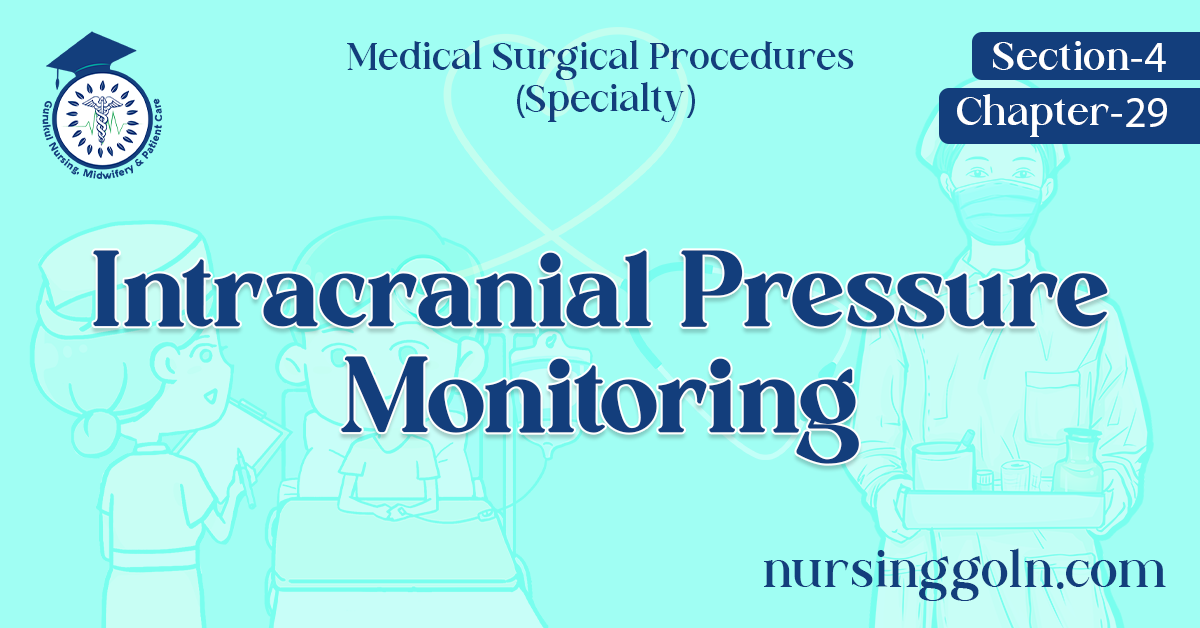Today our topic of discussion is Intracranial Pressure Monitoring.
Intracranial Pressure Monitoring

INTRACRANIAL PRESSURE MONITORING
Definition
Intracranial pressure monitoring measures the pressure exerted by the brain, blood and cerebrospinal fluid against the inside of the skull (Fig. 29.77)
Indications
- Head trauma with bleeding or edema
- Over production or insufficient absorption of .
- Cerebral hemorrhage and space occupying lesion CSF
Classification
- Intraventricular catheter monitoring: In this procedure, which monitors ICP directly, the doctor inserts a small polyethylene or silicone rubber catheter into the lateral ventricle through a burr hole
- Although, this method measures ICP most accurately, it carries the greatest risk of infection. This is the only type of ICP monitoring that allows evaluation of brain compliance and drainage of significant amounts of cerebrospinal fluid
- Contraindications usually include stenotic cerebral ventricles, cerebral aneurysms in the path of catheter placement and suspected vascular lesions.
- Subarachnoid bolt monitoring:This procedure involves insertion of a special bolt into the subarachnoid space through a twist-drill burr hole that is positioned in the front of the skull behind the hairline .
- Placing the bolt is easier than placing an intra-ventricular catheter, especially if a computed tomography scan reveals the cerebrum has shifted or the ventricles have collapsed.This type of ICP monitoring also carries less risk of infection and parenchymal damage because the bolt does not penetrate the cerebrum.
- Epidural or subdural sensor monitoring: ICP can also be monitored the epidural or subdural space. For epidural monitoring, sensor is inserted into the epidural space through a burr hole. This system’s main drawback is questionable accuracy because ICP is not being measured directly from a CSF-filled space.
- For subdural monitoring, a fiber-optic transducer tip is placed on brain tissue under the dura mater. The main drawback to this method is its inability to drain CSF.
- Intra-parenchymal monitoring: In this procedure, the doctor inserts a catheter through a small subarachnoid bolt and after puncturing the dura, advances the catheter a few centimeters into the brain’s white matter.
- There is no need to balance or calibrate the equipment after insertion. Although this method does not provide directly access to CSF measurements are accurate because brain tissue pressure correlate well with ventricular pressure.
- Intraparenchymal monitoring may be used to obtain ICP measurements in clients with compressed or dislocated ventricles.

General Instructions
- ICP monitoring can detect elevated ICP early, before clinical danger signs develop, prompt intervention can help avert or diminish neurological damage caused by cerebral hypoxia and shifts of brain mass
- The four basic ICP monitoring systems are intra- ventricular catheter, subarachnoid bolt, epidural sensor and intraparenchymal pressure monitoring
- Regardless of which system is used, the procedure is always performed by a neurosurgeon in the operating room, emergency department or critical care unit Insertion of an ICP monitoring device requires sterile technique to reduce the risk of central nervous system (CNS) infection Setting up equipment for the monitoring system also requires strict asepsis.
Client and Environment Preparation
- Explain the entire procedure to the client or his family
- Obtain informed consent
- Determine whether the client is allergic to iodine preparations
- Monitoring units and setup protocols are varied and complex and differ among health care facilities.
Equipment
- Monitoring unit and transducers as ordered 16 to 20 sterile 47/4″ gauze pads
- Linen-saver pads
- CWaves
- B wave, C wave are rapid and rhythmic, but they are not as sharp
- Clinically insignificant, they may fluctuate with reparations or systemic blood pressure changes.

After Care
- Positioning the drip chamber too high may raise ICP: positioning it too low may cause excessive CSF drainage
- Inspect the insertion site at least every 24 hours for redness, swelling and drainage .
- Clean the site, reapply povidone-iodine solution and apply a fresh sterile dressing
- Assess the client’s clinical status and take routine and neurological vital signs every hourly or as ordered.
- Make sure you’ve obtained orders for waveforms and pressure parameters from the doctor.
- Calculate cerebral perfusion pressure (CPP) hourly: use the equation CPP- MAP-ICP (MAP refers to mean arterial pressure).
Read more:
